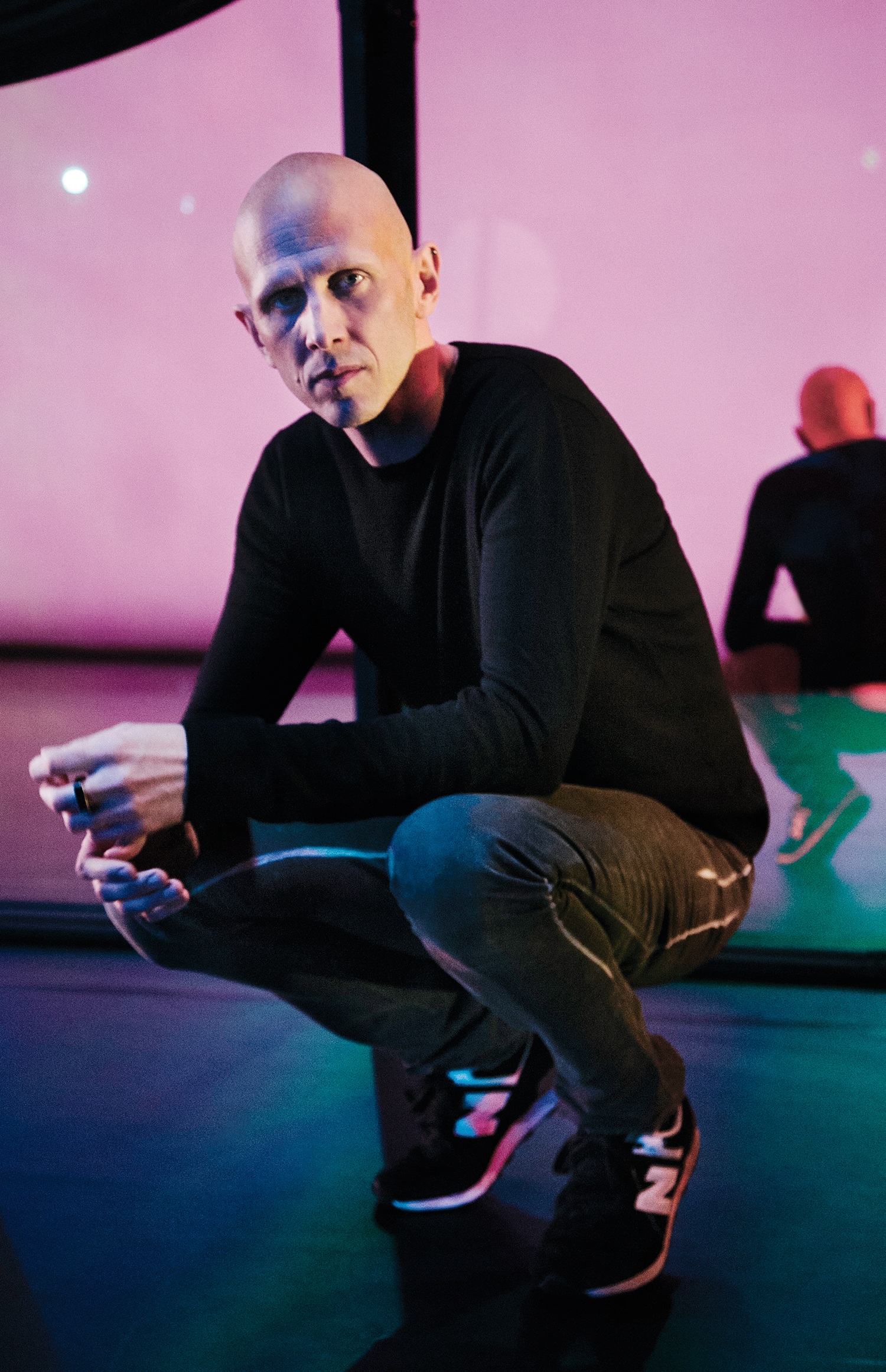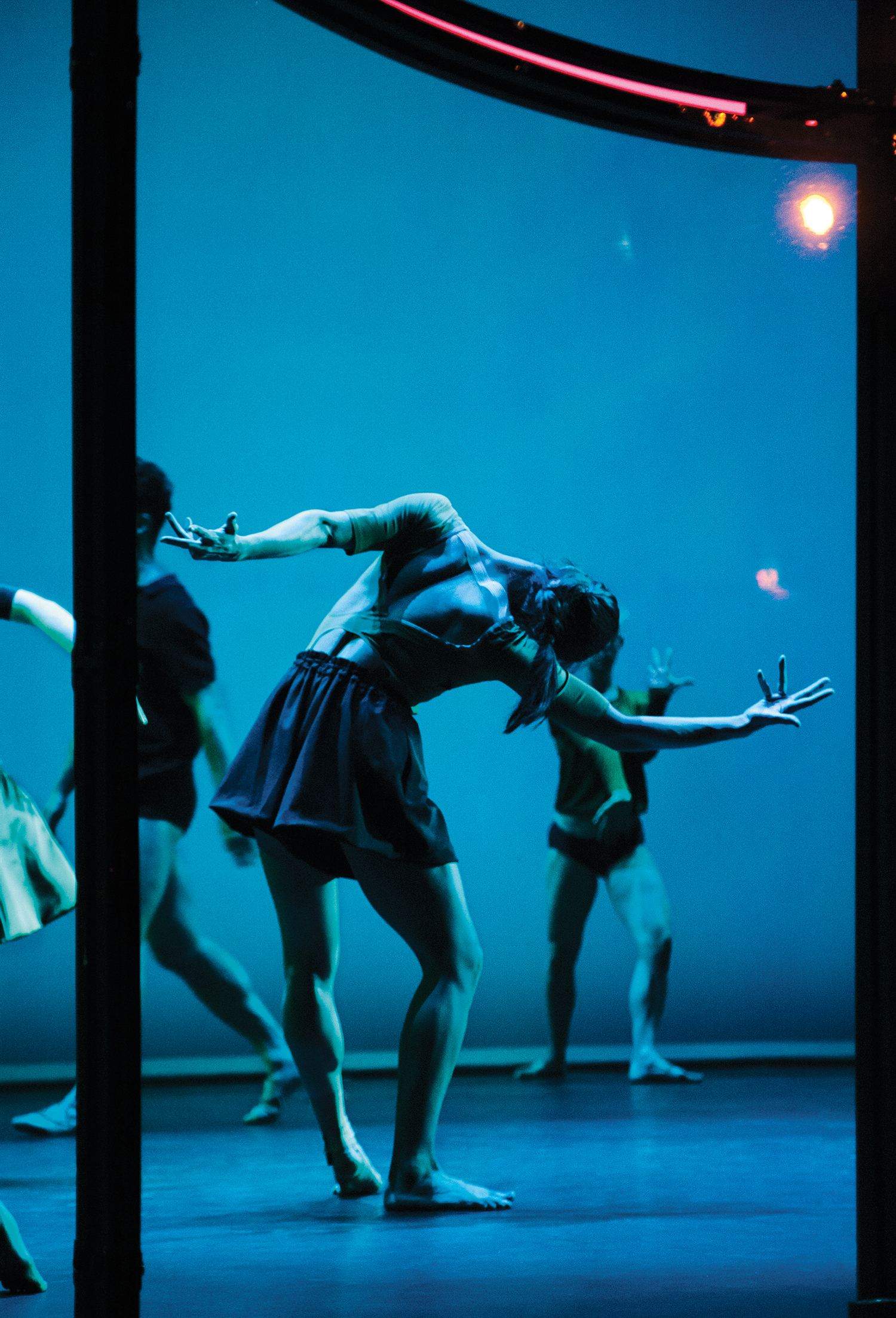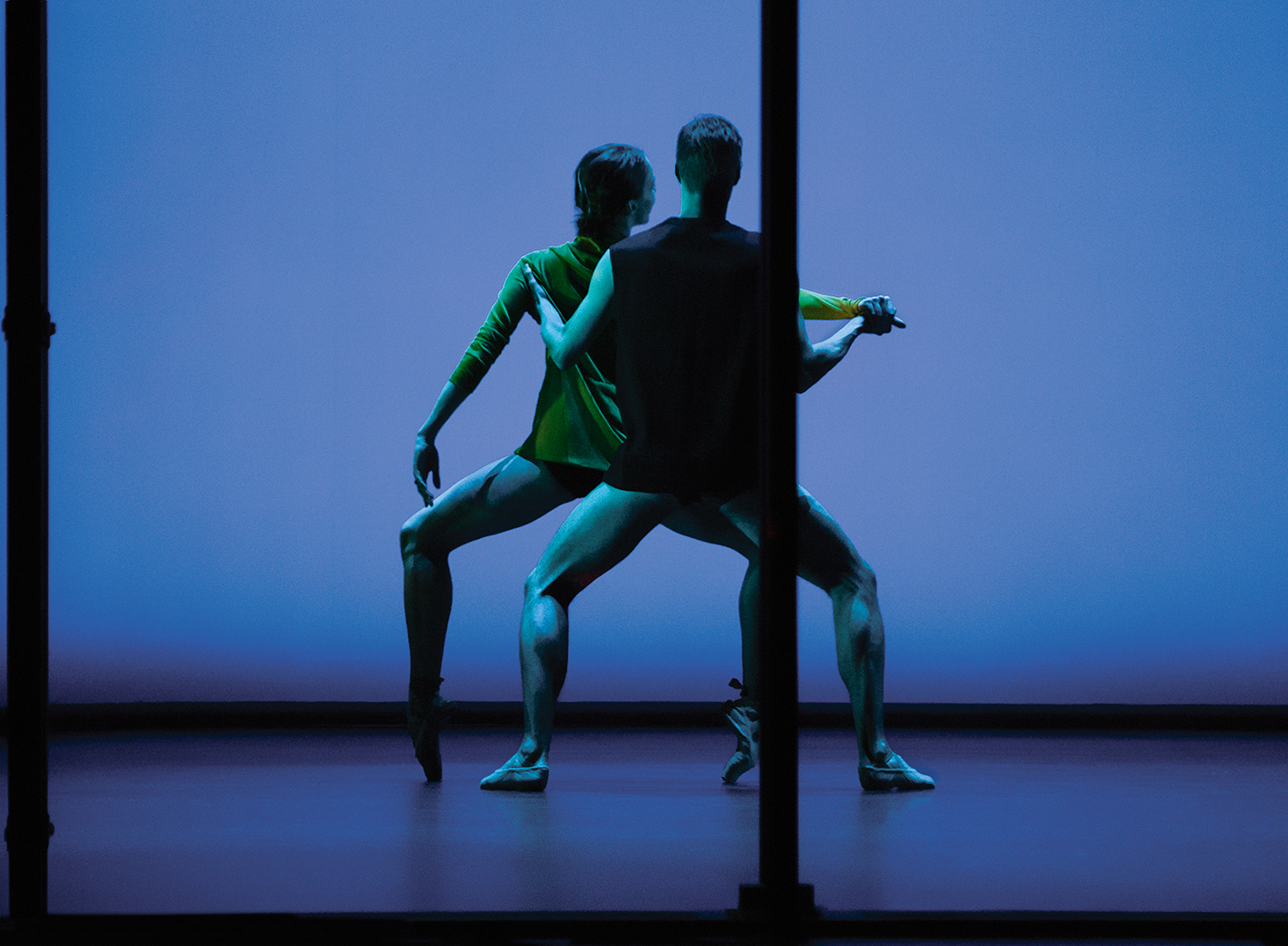Purple Magazine
— F/W 2015 issue 24
Wayne McGregor
 Wayne McGregor
Wayne McGregor
on being a choreographer
interview by SVEN SCHUMANN
portrait by DAISY WALKER
Wayne McGregor is the most exciting choreographer ballet has seen in years, pushing limits with his non-traditional, experimental approach. Even though he has no proper ballet training, the biggest stages line up to work with him. Since 2006, he has been the resident choreographer at The Royal Ballet in London, done pieces for institutions like the La Scala Theatre Ballet in Milan, the Paris Opera Ballet, and the New York City Ballet. He also owns his own dance company, Wayne McGregor Random Dance. His latest work, a collaboration with the artist Olafur Eliasson and the musician Jamie xx, premiered at this year’s Manchester International Festival.
SVEN SCHUMANN — The ballets I have been to were all quite different from the ones you are making. How would you describe your unique style of choreography?
WAYNE MCGREGOR — I see beauty in things that are dysfunctional rather than just pure line and shape. The aspiration of classical ballet, particularly, has often been about a kind of grace and effortlessness and lyricism in the body, an instrument that’s in fantastic motion. I think that’s really interesting and really beautiful, but I also think there’s a whole other range of physical potential that a human body can do, which is also interesting to explore and evokes feeling and meaning in people watching it. So, I’m interested in that side of it. I’m interested in bodies misbehaving.
SVEN SCHUMANN — Where do you think that comes from?
WAYNE MCGREGOR — I’ve always had a very long body, so I’ve been able to do things differently. I was doing body-popping and a lot of club stuff when I was around 18, when rave culture came around. That kind of permeates the way in which you see people move. I’ve not been in a classical ballet school where you’ve seen bodies move in a particular way since the age of eight.
SVEN SCHUMANN — You never had any traditional ballet training?
WAYNE MCGREGOR — No. And that’s why it was so strange that I would get these really amazing jobs at places like The Royal Ballet, where I was the first resident choreographer who had never trained in a royal ballet. But I think none of that matters. Being a choreographer is about the biomechanics and signature of the body. Everybody carries their own physical history, so it doesn’t matter if you’ve trained in hip-hop or rave dancing or body-popping or classical ballet. It’s all the same, really.
SVEN SCHUMANN — Did you go back to gain the technical knowledge necessary to talk to professional dancers?
WAYNE MCGREGOR — Kind of. I did a degree in choreography and semiotics, as well as contemporary dance training, but I got my practice in ballet through doing it, right? So the first time you ever work with somebody on pointe shoes, you ask them, “What can you do?” I had no idea what you can do! But less important than knowing how the pointe shoe works is to have good dancers in the room who, when you say, “Can you try that?”, they can go, “Oh no, but I can do this.”
SVEN SCHUMANN — Because you want your dancers to be collaborators?
WAYNE MCGREGOR — In a way. I think choreography is about 80% psychology: it’s working out what that dancer in front of you is prepared to do and where they’re prepared to go. It’s a dialogue. I try to work with the best people possible and suck out their brilliance as much as possible. The job of a choreographer is to find what’s personal to them. When I worked with Thom Yorke, I found out that he’s an amazing dancer. Full stop. He doesn’t really need a choreographer.
SVEN SCHUMANN — You based the choreography around his natural movement?
WAYNE MCGREGOR — Yes, and I think it should be like that for everyone! The whole “Lotus Flower” video is choreographed, but it comes from him, so he feels he owns it already. It’s not like he’s wearing a suit of clothes that he doesn’t feel comfortable in. He’s giving it to me, and I’m just helping him form it in a different way. When you’ve got somebody so extraordinary, it’s exciting for a choreographer; it’s effortless.
SVEN SCHUMANN — Do you approach professional dancers differently?
WAYNE MCGREGOR — With all great dancers, sometimes technique gets in the way of letting them be curious and open and try new things. Their idea of physical beauty gets in the way of them exploring. For me, there’s no point in being an artist now and just repeating things that happened in the past. It wouldn’t get me up in the morning.
SVEN SCHUMANN — How do you deal with the weight of tradition that a lot of people put on ballet?
WAYNE MCGREGOR — I don’t worry about it. I think classical ballet is a contemporary art form, and we just describe it badly. We’re always talking about it in relation to its past, but I think that’s only exciting if you’re in dialogue and tension with it, not just repeating the past. I’ve been at Covent Garden for 10 years now, and you’d expect it to be extraordinarily conservative, but that is an organization of, like, 300 people who are all super-creative and want to be there. They want to be working with people who are alive, for a start! [Laughs]
SVEN SCHUMANN — Not doing pieces based on the work of dead choreographers.
WAYNE MCGREGOR — Yeah, the dancers want to work with people who make something they are the first people ever to have done. That’s very motivating. All of a sudden, history and tradition become something else. That’s very exciting.
SVEN SCHUMANN — And you are reaching a different audience as well if you are using songs from The White Stripes instead of Swan Lake.
WAYNE MCGREGOR — Yeah, exactly. There are no rules! The ballet is often defined by rules that it imposes upon itself. If you go from a point of view where there are no rules, and therefore the audience shouldn’t necessarily know what to expect, that’s a really healthy thing. But some people don’t like that, right? And that’s fine with me. All I can do is work with interesting people and hope others will commission it.
SVEN SCHUMANN — How do you pick the people you collaborate with? For example, your latest piece, Tree of Codes, was a collaboration with Olafur Eliasson and Jamie xx for the Manchester International Festival.
WAYNE MCGREGOR — Usually, I look for something that I find interesting and start researching that. Then I find people that I think might also be interested in it, whether a musician, a visual artist, or a scientist. Then we have conversations a couple of years in advance. You can only collaborate with people if you talk to them. You want to be in the room with them. Something always comes up that you would never have imagined, and that then becomes a piece. If you’re working with Olafur Eliasson, of course you want to be with him! You want to be at his studio in Berlin; you want to see his show at the Louis Vuitton Foundation in Paris; you want him to be in the studio with you. Did you know that he’s a brilliant dancer?
SVEN SCHUMANN — He actually just told me last week that his first art piece was his breakdancing.
WAYNE MCGREGOR — Yeah, he used to be a popping champion. He’s absolutely brilliant. I saw The Weather Project years ago at the Tate because the choreographer Merce Cunningham did a site-specific performance in it, and it was by far the best dance performance I have ever seen. It just resonated with me in so many ways. I’ve been following Olafur’s work for ages, and I love how he uses low-tech means to make otherworldly environments. I love how he really does try to touch audiences and make the experience immersive.
SVEN SCHUMANN — Your piece Tree of Codes is based on a novel of the same name by Jonathan Safran Foer, who described the book thusly: “I took my favorite book, Bruno Schulz’s Street of Crocodiles, and by cutting out words carved out a new story.” Is your approach to the project a similar transformation of the source material?
WAYNE MCGREGOR — Totally, it’s like a translation. What’s interesting about Tree of Codes is that I saw an amazing Complicite theater piece of Street of Crocodiles in the ’90s, so I experienced the book first through theater. And the way I experienced Olafur for the first time was through dance, through Merce. So you don’t always get things in their original states. I’m not interested in telling that story on the stage as a direct translation. I think it’s much more potent for us to use that as a point of departure and see where it can go. I would love now, after we make the piece, for Jonathan to write a short story about the piece. I’ll have to ask him; I think that would be really great. We could use it as this kind of iterative thing.
SVEN SCHUMANN — Were you worried that Olafur or Jamie might have difficulty adapting their work for the stage?
WAYNE MCGREGOR — I work a lot with people who’ve never done anything for the stage, and it never worries me. For this, Jamie invented a computer program so that each page of Tree of Codes, with the holes cut out, is played rhythmically, and it gave him a kind of beat structure that he then built songs from. Then I choreographed all the pages, and Olafur found and invented the spaces that were in the pages for the stage. It’s been quite interesting from that point of view, all of our different approaches. For me, the collaboration is putting in time to get to know somebody’s practice, and if you do that, then the piece makes itself.
SVEN SCHUMANN — How did you go about putting the piece together between your various practices?
WAYNE MCGREGOR — I tend to choreograph the pages, so sometimes you do the emotional content of the page or the graphic content of the page or an improvisation from the page. I’ve got this bank of stuff, and Jamie has this bank of stuff. He’ll send me some stuff, and I’ll start to go, “Okay, that sounds to me like it has the feeling of this,” and I grab this thing and see if it works together. It does? Then I’ll start to build this up and give some notes back to Jamie. He’ll build up the track, I’ll build up the structure, and then I have something. And then we’ll have these bigger bits of things and realize that if you put them in a certain order, and it has a certain relationship with Olafur’s set, it might be an interesting journey for the audience. But we probably won’t find the final form until we’re in the theater. We really need Olafur’s piece before we know. We’re as prepared as we can be, but when we get to that stage, it’s going to be different.
SVEN SCHUMANN — That sounds nerve-wracking but also freeing at the same time.
WAYNE MCGREGOR — I’ve got these amazing dancers that are so adaptable and mentally flexible that if I completely reordered the thing on the night before, they would still perform brilliantly. That’s part of their discipline. It’s amazing because it means you don’t have to fix things too early. People think rehearsing is about polishing, about making it perfect, and I’m just not into that. If the performance is on a Wednesday, I’d rather restructure the whole thing five times till the night before to see what the possibilities are than make sure they are all dancing exactly the same. Making something or creating something is about looking and exploring the potential, and I want to do that right up until the day of the performance. And then when we’re performing, I want to do it a bit more. There’s no reason we can’t.
END






















































































































































